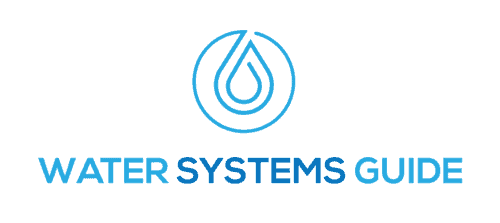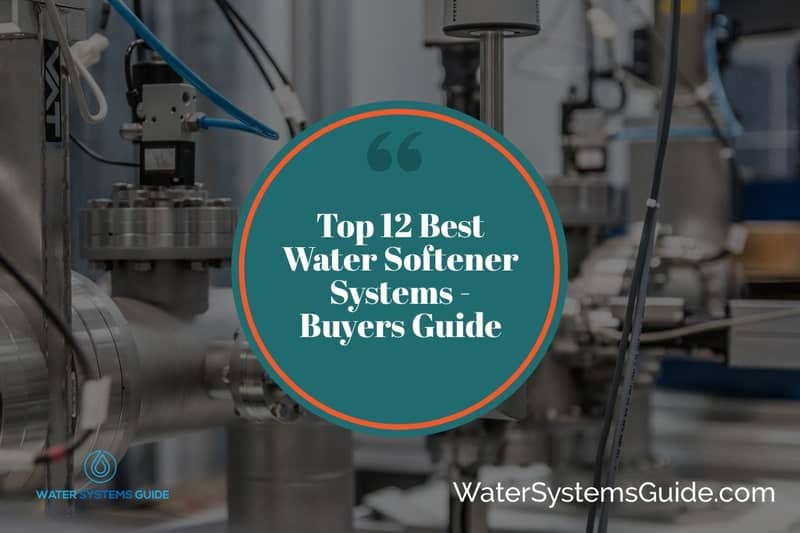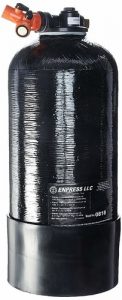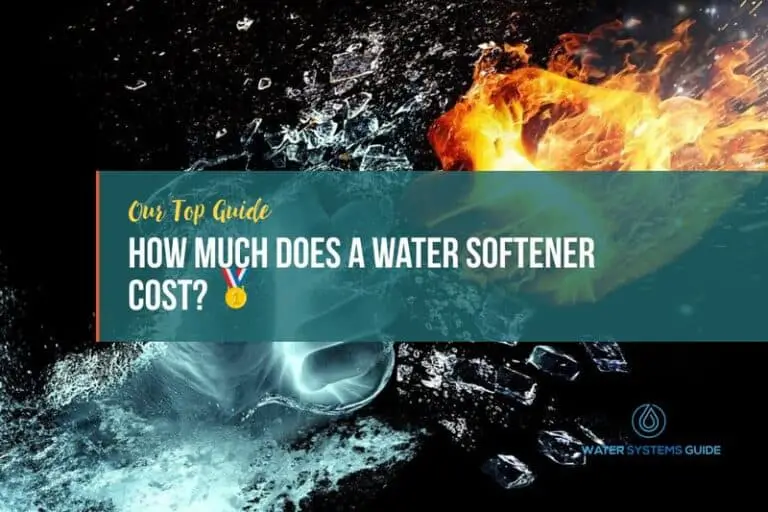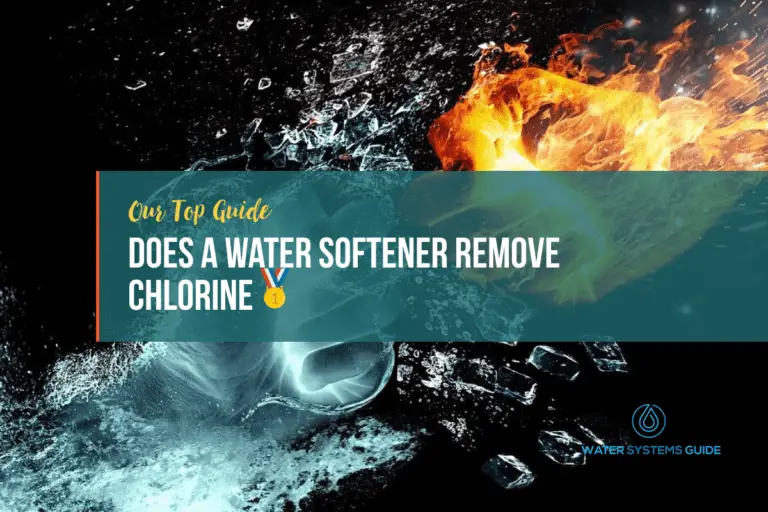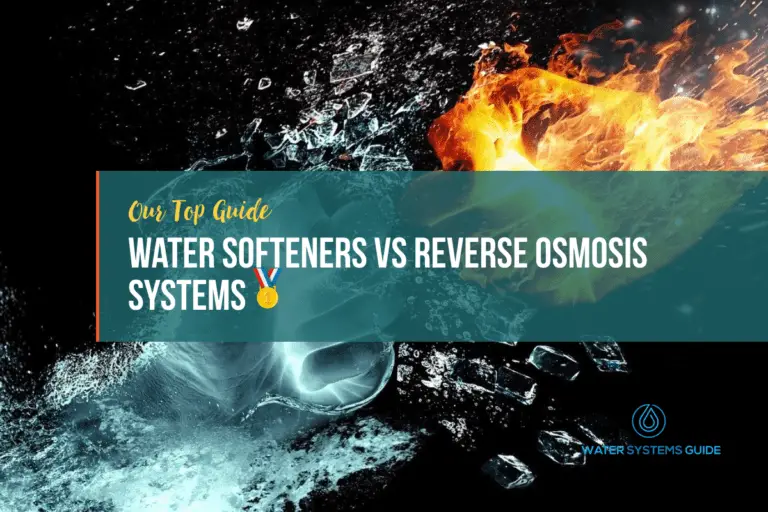Top 12 Best Water Softener Systems🥇(April 2025)
Last Updated: 09 April 2025
In this article, we’re going to be talking about the best water softener systems that are available on the market.
Regardless of where you live, hard water is a problem you can do without.
Apart from leaving difficult-to-ignore stains on cutlery, glasses, and fixtures, it can also leave deposits of calcium and other materials on your plumbing system. Worse, if you don’t tackle the problem proactively, you might end up facing major leaks in your household.
Hence the reason why we recommend you get a water softener system.
While their one-time cost is undoubtedly high, the amount (and stress) it will save you by defeating the hardness of water means that that’s a price worth paying if you don’t want to have second thoughts while consuming your municipal water.
✅What is a water softener system?
As its name implies, a water softener is a filtration system that works to remove all impurities from water which are the reason for its hardness. These impurities include deposits of calcium and magnesium. When hard water flows through the water softener, it filters out these impurities to deliver the softened water through its exit. The can be used in both commercial and residential environments.
💧What is the best water softener system?
At the cost of sounding politically correct, all the water softeners that you see in this water softener review are the best-performing ones. Whether it is their cost, Amazon reviews or performance, all of them perform much better than their counterparts which you don’t see in this water softener review article. We’ve done hours of research to find only the best water softener systems, all of which we talk about within this article.
🚰What is hard water?
Any water which contains the dissolved impurities of calcium and magnesium, among other minerals, in hard amount is known as hard water. Specifically speaking, if the concentration of calcium carbonate is more than 7 grains per gallon (gpg), it can be termed as hard water.
However, it isn’t the only unit to measure how hard your water might be. Other units including parts per million (ppm) or milligrams per liter (mg/L) to measure the hardness level.
💧What is the difference between soft water and hard water?
Following are some of the key differences between soft water and hard water:
– Deposits of calcium and magnesium: If your water contains more than 17 mg/L deposits of calcium and magnesium, it is hard water. Anything less, and you don’t need a water softener system because you’re using soft water
– Mineral taste: Although we don’t recommend that you do it, drinking hard water would give you a mineral taste – one which won’t be there if you’re consuming soft water.
– Signs of residue: If you’re using hard water in your household, you might be seeing stains on cutlery, glassware and bathroom appliances. Soft water doesn’t leave such deposits
– Dry skin and hair: In addition to making your skin dry, hard water will leave your hair scaly. Needless to say that it won’t happen if you’re using soft water.
🚰What are the types of water softener systems?
Following are the four most common types of water softener systems for treating hard water:
Ion Exchange Systems
Also known as salt-based water softeners, these treat hard water by replacing the calcium and magnesium present in water with their built-in salt, hydrogen or potassium substances. The reason why you see salt in most ion-exchange system is that it’s the most inexpensive option.
Assuming you end up getting an ion exchange system, the whole system would comprise of a resin tank and a brine tank. As water passes through the resin rank, its hardness causing ions are replaced with sodium or potassium ions. As the cycle goes on, more and more water is softened.
Pros– Inexpensive option – Effective produces soft water – Commonly available |
Cons– Possible downtime if you use a single-tank system |
Descaling Systems
Descaling systems, which are known in common parlance as salt-free water softener systems, don’t rely on minerals or chemicals to soften water. Instead, these water softeners use Nano-technology which, in turn, changes the structure of water molecules to change their physical and chemical properties.
As a result, the water molecules which were previously known for building scales are now turned to non-scale building. The restructuring of water molecules happens when they’re flowing through the filter media. You might need a descaling system if your plumbing is facing problems of rust.
Pros– Use no chemical – Requires less maintenance – Doesn’t waste soft water |
Cons– Pricier than most types of water softeners |
Best Water Softener Systems Review – Top 12
Watts Water M7002 RV-Pro
It may not be as powerful as some of the other softener systems you see in this water softener review article, but the Watts Water M7002 is a clear winner when it comes to compactness. It is designed for RVs with low water usage and its 10,000-grain capacity is enough to meet most requirements.
Technical Specs
– Type: Ion-exchange
– Flow Rate: 4GPM
– Capacity: 10,000 grains
– Bypass Valve: Not needed
– Metered regen: No
General Specs
– Price: $
– Dimensions: 22 x 10 x 10 inches
– Weight: 9 pounds
– Kit includes: 3/4″ Female x Male Y Valve, 3/4″ Male NPT x 3/4″, 8×18 Black Mineral Tank,
– Male Garden Hose Adaptor3/4″ Female NPT Inlet/Outlet Tank Head, 3/4″ Female Garden Hose x 3/4″ Male NPT Adaptor, 3/4″ Garden Hose Gasket, 13/16″ Belled Distributor Tube, Hardness Test Strips (50 test strips per bottle), Resin media
– Warranty: 1-year (limited)
Features
First things first, the fact that this water softener comes with no smart features means it won’t blow a hole in your pocket. That is curious given the fact that this water softener has a 10,000-grain capacity, one which enables it to handle the most demanding hard water applications.
Turning our attention to its performance, and its 4GPM flow rate isn’t enough for a whole household – which is why this unit is designed for an RV. Also, since it comes with customizable flow valves, you can regulate the intake of water based on your requirements.
Furthermore, if things start to go wrong, you can turn to the built-in drain valve of this water softener to empty it in no time. You might also find it good to know that this water softener uses almost any kind of salt as its resin media, which means that its running costs will remain low.
On top of everything else, the one thing which we really liked about the M7002 RV Pro is its water regeneration. Thanks to the built-in flow restrictor, it needs only 20 minutes of freshwater to regenerate the resin. And as long as you regenerate it once a month, it will remain with you for years to come.
What we don’t like
The absence of automation in the Watts M7000 RV Pro comes across as a double-edged sword. On one end, it keeps the costs low, thereby making this unit appetizing for your budget. On the other, however, it forces you to manually regenerate its resin media between every 1 and 4 weeks. Additionally, its 4GPM flow rate for treated hard water means you’re restricted to one shower at a time.
Pros
- 10,000-grain capacity
- Has customizable flow valves
- Only 20 minutes of freshwater for regeneration
- Provides hardness strips
Cons
- Flow rate is on the lower side
Aquios AQFS220
The Aquios AQFS220 is one of those whole-home water softeners which doesn’t rely on salt to remove the hardness of your municipal water and also provides a filter system in its package. And the cherry on top? It comes with a 20-year warranty.
Technical Specs
– Type: Salt-free water softener
– Flow Rate: 12-15 GPM
– Capacity: 40,000 gallons
– Bypass Valve: Included
– Metered regen: No
General Specs
– Price: $$
– Dimensions: 5 x 23.5 inches
– Weight: 7.5 pounds
– Kit includes: Housing Head with built-in bypass valve, Housing Collar, O-ring, White sump, ¾’’ stainless steel U-bracket, softener/filtration cartridge, collar wrench, 1 ½’’ screws, ¼’’ anchors, installation manual, cartridge spec sheet
– Warranty: 20-year
Features
Starting with the best feature that the Aquios Water Softener has to offer, it comes as an all-in-one system that not only softens your water but also filters it, eliminates the scale and delivers the clean water to your faucets without any pressure loss.
In case you’re wondering, the reason why this water softener is able to do all of this is that it is delivered as a double-acting system. Put simply, it contains a water softener and water filter – the first of which softens water whereas the water filter helps remove sediments.
To soften water, the Aquios AQFS220 doesn’t rely on salt. Instead, it uses commercial technology which prevents the buildup of minerals in your pipes and minerals. As for its filtration, this system uses a carbon black filtration cartridge which helps remove sediments, taste, and odor from your drinking water.
Furthermore, since the cartridge which comes in the package has a capacity of 40,000 gallons, an average family of 6 persons won’t feel the need to replace it for at least 6 months. And despite doing all of that, the one-tank design of the home water softeners ensures that it doesn’t occupy much space on your shelf.
What we don’t like
You might not have to worry about replacing the salt resin, but one thing which you’d have to do is replace the filter cartridge occasionally. The time between each replacement will vary depending on your usage, however, each new cartridge will set you back between $59 and $69.
Pros
- Softener and filter
- Requires no electricity
- Comes with a great warranty
- Compact and slim design
Cons
- Cartridges must be replaced occasionally
Triple Action Poly Salt-Free
When placed on a table in front of you, its diminutive shape might lead you to believe that this is another one of those one-faucet softeners. However, turn to its specs, and its mammoth 30GPM flow rate tells you everything that there is to know about this whole-home water softener system.
Technical Specs
– Type: Salt-free water softener
– Flow Rate: 30 GPM
– Capacity: N/A
– Bypass Valve: No
– Metered regen: No
General Specs
– Price: $$
– Dimensions: 4.5 x 4.5 x 10 inches
– Weight: 7.5 pounds
– Kit includes: 0.5 oz of Poly-phosphate and 2ea male threaded installation nipples
– Warranty: 2-year
Features
One of the major reasons why the Triple Action Poly Salt-Free Water Softener attracts users is its huge flow rate of 30GPM – one which is enough to inundate the whole household with clean water. This salt-free water softener can remove up to 25 grains of hardness from water and the whole unit is NSF certified.
This salt-free water softener uses an interesting mechanism to soften your municipal water. Once the contaminated water enters its premises, it goes straight to the 30-micron sediment filter – which removes extra-small dirt particles to make the water potable.
From there onwards, this salt-free water softener is treated by the polyphosphate coating material of this water softener. This treatment from a BPA-free material helps the water get rid of smaller material grains. As a result, the water would no longer stick to your appliances of plumbing systems.
Yet another feature of this water softener which lures its users is its ease of installation. You don’t need to hire a professional technician to have it installed in your home. All you need to do, instead, is turn off your main water supply and connect the system with the incoming water line.
What we don’t like
Most people turn to salt-free water softener systems thinking that they’d save money on resin-replacement costs. Unfortunately, that’s not the case with this water softener. Depending on your water usage, you might have to refill its polyphosphates every six to twelve months
Pros
- Huge flow rate
- 30-sediment micron filter
- Competitively priced
Cons
- Polyphosphates need regular refilling
Whirlpool WHES30E Softener
Talk about the brands you can trust while searching the best water softening system for your home, and the name Whirlpool comes right on top. The Michigan-based manufacturer has been churning out softeners for almost a century now and as you’d see with the WHES30E, it is pretty good at what it does.
Technical Specs
– Type: Salt-based softeners
– Flow Rate: 7.6 GPM
– Capacity: 30,000 grains
– Bypass Valve: Yes
– Metered Regen: Yes
General Specs
– Price: $$
– Dimensions: 19 x 18 x 43.5 in
– Weight: 102 pounds
– Kit includes: Softener system, bypass valve, installation kit, instruction manual
– Warranty: 2-year
Features
At the cost of sounding biased, not many water softeners in this water softener review article can compete with the Whirlpool WHES30E when it comes to its features. Take its design as an example. Despite weighing over 100 pounds, this water softener’s single-tank design means it won’t occupy much space on (or underneath) your shelf.
Furthermore, since it comes with NSF 44 certification, you should have no qualms about either the structural integrity of this water softener or its efficiency and grain capacity. One more area where this water softener excels is at iron filter – as it can remove clear-water (ferrous) iron at up to 8ppm.
To save both salt and water, the WHES30E comes with metered regeneration. This feature makes sure that the system only recharges when necessary, thereby saving water and salt. It does that by relying on a predictive algorithm that anticipates and predicts the time between two regen cycles.
If that wasn’t enough, Whirlpool tries to further sweeten the deal by supplying this unit with three warranties. You get a 10-year (limited) warranty on the tank, a 3-year (limited) warranty on electronics and a no-holds-barred 1-year warranty on all the remaining parts.
What we don’t like
For a system that provides so many features, there’s only one thing that can deter potential users from purchasing it: high price. Other than that, we were able to find nothing about the WHES30E which can act as a deal-breaker.
Pros
- Metered Regen
- NSF-certified
- Is an iron filter
- 30,000-grain capacity
Cons
- Pricey
Fleck 5600 Econominder
Similar to the Whirlpool WHSE300 that we reviewed earlier, the Fleck 56000 is also a metered water softener. Unlike it, however, the price of this water softener won’t cost you to rob a bank – so you might want to go for it if you want a high-end softener without the astronomical price tag.
Technical Specs
– Type: Ion-exchange
– Flow Rate: 12 GPM
– Capacity: 48,000 grains
– Bypass Valve: Yes
– Metered regen: Yes
General Specs
– Price: $$
– Dimensions: 19 x 18 x 43.5 in
– Weight: 102 pounds
– Kit includes: Standard square brine tank, Safety float, overflow drain valve, 1″ Noryl Plastic BYPASS
– Warranty: 2-year
Features
Certifications are one area where you can always count on the Fleck water softeners to deliver. The Econominder 5600 is tested by ANSI/NSF Standard 372 to prove its lead-free compliance. It is also certified by both the WQA as well as NSF/ANSI Standard 44 for its softening performance.
Furthermore, thanks to its on-demand water regen system, this system would regenerate only when necessary. As a result, it wastes little water and won’t pollute your water supply systems with excessive release of resin-based salts.
To keep overfilling at bay, it comes with a safety valve which adequately releases any excess water in case of oversupply. An additional backup is provided in the shape of the safety flow which would stop the system from taking water once its safe water limit has been breached.
Lastly, as is the case with other Fleck softeners, the Econominder 5600 too comes with a high-capacity water-softener resin. It reduces the pressure drop in treated water and lasts longer, thereby requiring less frequent refillings.
What we don’t like
As we found out while trying to install this system, some of the instructions given in its manual are either inadequate or downright useless. Fortunately, there is plenty of support online using which we were able to install it.
Pros
- Only regenerates when necessary
- Prevents overfilling through the safety valve
- Backup drain valve
- Has loads of certifications
Cons
- The instruction manual is lacking in some details
Fleck Iron Pro 2
For those of you who have been drawing their water from a well, iron tops the list of nuisances that you have no choice but to deal with. That means that you need a softener which is designed to remove iron, and that’s exactly what the Fleck 56000SXT Iron Pro 2 offers.
Technical Specs
– Type: Ion-exchange
– Flow Rate: 16 GPM
– Capacity: 64,000 grains
– Bypass Valve: Yes
– Metered regen: Yes
General Specs
– Price: $$$$
– Dimensions: 19 x 18 x 43.5 in
– Weight: 119.5 pounds
– Kit includes: Digital Control Head, 1’’ Bypass valve, 12’’ x 48’’ structural tank
– Warranty: 10-year
Features
Strong capacity is one of the unique selling points of the Fleck 5600SXT. It offers 5 different capacity options, ranging between modest 32,000 grains and a whopping 80,000 grains. Such versatility means you’ll always have the right amount of soft water coming into your home.
If you’re familiar with hardness levels, you might recall that water with more than 120 ppm of calcium or magnesium deposits can be categorized as hard water. The Iron Pro 2 has enough resin to treat very hard water, with its technology allowing it to remove up to 1456 ppm of hardness causing substances.
As the name of the water softener, Iron Pro, implies, it can remove both ferrous iron and ferric iron via its ion exchange process. You’d immediately notice that iron is no longer coming with your water supply, as the metallic taste of your drinking water and the brownish stains on your tiles would exist no longer.
Finally, there are two ways you can get this water softener to auto-regenerate: either when a certain amount of time has passed, or after a certain amount of water. Its digital touchpad controls are user-intuitive and you won’t have to spend more than a couple of minutes to set things up.
What we don’t like
We can agree that this water softener offers many features – like removing iron – which you won’t get in many other water softeners. Still, what we don’t like about those features is that they come at a huge cost, one which makes the Iron Pro 2 the most expensive water softeners in this water softener review article.
Pros
- Removes iron
- User-intuitive touchpad control
- Auto regenerates using hard water
Cons
- Astronomically expensive
Aquasure Harmony Series
The Aquasure Harmony Series is an easy, cost-effective solution which removes hardness from your water and whose high-grain capacity allows it to provide enough soft water for your entire household.
Technical Specs
– Type: Ion-exchange
– Flow Rate: 12 GPM
– Capacity: 64,000 grains
– Bypass Valve: Yes
– Metered regen: Yes
General Specs
– Price: $$$
– Dimensions: 56.5 x 30.2 x 16.5 inches
– Weight: 149 pounds
– Kit includes: High strength corrosion resistant fiberglass lined polyethylene tank, durable bypass valve, and prefilled premium-grade resin for hard water treatment
– Warranty: 5-year
Features
Water softeners have one main purpose – to remove hardness-causing minerals. The Aquasure Harmony Series has a high-quality 8% resin which is pretty good at doing that. It provides a more-than-decent flow rate of 12 GPM and can treat mild-to-moderate hard water.
Impressively for a budget water softener, the Aquasure Harmony comes equipped with a digital control head. It carefully calculates your water usage based on the water that goes through the system. Based on the results that come out, it completes a backwash cycle to help the system maintain its efficiency.
Apart from the manual backwash option – which offers a one-button regeneration option, you get three more including featured, time-delayed and metered. While the featured mode works automatically, the time-delayed mode regenerates the resin after a certain passage of time.
Then there is the metered mode which calculates your water usage before issuing commands to the digital control head to regenerate the resin. The control head, meanwhile, is fully customizable to fit any special applications and individual needs.
What we don’t like
The Aquasure Harmony comes in three different sizes – 32,000 grains, 48,000 grains, and 64,000 grains. While the first two are easy to carry, the last one, when it is filled with resin up to capacity, can become very heavy.
Pros
- 64,000 grains capacity for hard water
- Three regeneration options
- Digital meter control head
Cons
- Heavy
Nuvo H20 Dphb-a
While the inexpensiveness of salt allows water softeners using it as a resin to come across as a budget option, it’s a fact that salt-based water softeners use more water, cause more pollution and can’t do much against lead levels. It is why the Nuvo H20 DPHB has foregone salt in favor of chelation.
Technical Specs
– Type: Chelation
– Flow Rate: 15 GPM
– Capacity: 50,000 grains
– Bypass Valve: Yes
– Metered regen: No
General Specs
– Price: $$$$
– Dimensions: 5 x 5 x 24 in
– Weight: 8 pounds
– Kit includes: Nuvo System, Nuvo cartridge, Mounting black plate, mounting bracket, screws, housing wrench, user manual
– Warranty: Lifetime
Features
There are two types of water softeners that you might find on the market. The first type uses salt to capture calcium and magnesium minerals, which cause hardness. The second type, to which the Nuvo DPHB belongs, uses technology and are therefore known as salt-free softener systems
Instead of relying on salt, this salt-free water softener is equipped with special cartridges which use chelation to bind hard mineral ions and reduce water’s pH-levels. You might think that it won’t remove hardness but as the NSF Standard 169 certification of this water softener shows, it’s pretty good at removing hardness from your water.
Since this water softener for home requires no salt to treat water, it can afford a single-tank design without requiring a second one for mixing brine. That choice has made this unit ultra-compact, which means it won’t require much space for installation.
Lastly, when setting up the Nuvo DPHB, you won’t have to go through complex programming. All you have to do, instead, is to remember that after every 6 months or 50,000 gallons, you’d have to replace the cartridges. And there’s no need to worry as replacing the cartridge isn’t that hard to do.
What we don’t like
There are two instances where the manufacturer advises against using this water softener. First, if you’re drawing your water from a private well, the Nuvo DPHB won’t come handy. Second, for it to be effective, it is crucial that the pH-level of your water is above 7.2.
Pros
- Impressive flowrate
- No need for regeneration
- 50,000 gallons capacity
Cons
- Won’t come handy in all situations
Fleck AFW Filters
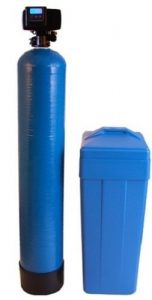
Not many water softening systems out there are easy-to-control. Some who do aren’t reliable and effective at what they do. The Fleck AFW Filter, however, is one of those rare water softening systems which provides all these three gifts in the same box.
Technical Specs
– Type: Ion-exchange
– Flow Rate: 14-16 GPM
– Capacity: 64,000 grains
– Bypass Valve: Yes
– Metered regen: Yes
General Specs
– Price: $$$
– Dimensions: 52 x 12 x 12 in
– Weight: 20.8 pounds
– Kit includes: Standard 1″ MNPT thread, Bypass valve, standard brine tank, metered control head, Resin, safety float
– Warranty: 5 year/10 year
Features
Similar to most water softening systems on the market, this water softener also offers metered regeneration after a specific time period. Unlike, most of them, however, its mechanism isn’t complicated, as it relies on actual usage data before ordering the brine tank to rejuvenate itself.
While it might not appear that way, the regeneration mechanism isn’t that complicated. The system measures your water usage, looks at the remaining percentage of salt in the tank and regenerates itself following your preset cycle or after reaching its maximum capacity, whichever arrives first.
Since this is a digital water system you get a small LCD screen which makes you aware of the system’s current status. It contains a digital touchpad which you can easily operate and shows error codes when things start to go south. To decipher those codes, you might have to turn to the user manual.
To give this water softener with their seal of approval, NSF has bestowed this water softener with their standard 44. That, in turn, has allowed WQA to certify this water softener as well. This double-certification means that you can count on the AFWFilters to address most of your hard water issues.
What we don’t like
Deciphering the error codes which might operate on this water softener’s LCD screen will take you to its instruction manual. Once you’re there, you’ll realize why people hate it. To put it mildly, it’s not very clear at doing the only thing it’s supposed to do; providing instructions.
Pros
- NSF Standards’ certified
- Easy to control
- Real + Auto regeneration
Cons
- The instruction manual isn’t clear
Aquasana Simply Soft Descaler
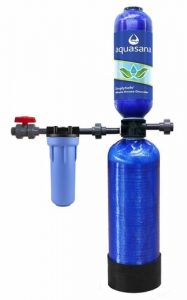
Though not as popular as most of the other systems you see in this review, the Aquasana claims to be pretty effective at what it does. As we found out while trying to gauge the veracity of this claim, this water softener has every right to make it.
Technical Specs
– Type: NAC
– Flow Rate: 7-10 GPM
– Capacity: 6 years
– Bypass Valve: No
– Metered regen: No
General Specs
– Price: $$$
– Dimensions: 8.5 x 8.5 x 42 inches
– Weight: 32 pounds
– Kit includes: Two tanks, one filter, valve
– Warranty: 6-year (limited)
Features
At the cost of sounding technical, the Aquasana Simply Soft doesn’t rely on harsh chemicals or salt to treat your water. It does the same via its Nucleation Assisted Crystallization (NAC) softening technology which, apart from twisting your tongue as you try to say it, also removes hardness.
The technology does that by altering the binding characteristics of calcium and magnesium, two minerals which are famous for causing hardness. As this digital water softener does that, both the minerals bind to each other and leave your plumbing system and water heater alone.
What’s more, with calcium and magnesium ions busy making love with each other, your skin will feel a lot softer after taking a bath. That’s because this digital water softener also comes with a 5-micron sediment filter which traps bigger review contaminants to give your skin a soft touch.
Finally, if you want to busy yourself with technicalities, this digital water softener’s flow rate is rated at a solid 7 to 10 gallons per minute. It can deal with water with hardness levels up to 25 grains per gallon and claims to have a rated softening capacity of 6 years.
What we don’t like
Most users might not know it but this unit recommends that you get it installed from a pro. Otherwise, if you are in a DIYer mood, you might end up voiding the warranty of this electronic
Pros
- No water wastage
- Reduces stains, spots,
- Removes scale on faucets
Cons
- Requires that you get it installed from a pro
ABC Waters Built Fleck 5600SXT
If you came in search of a high-quality, fair budget water softener – one that has enough flow rate to supply your entire household with clean water, this might exactly be the water softener for you.
Technical Specs
– Type: Salt
– Flow Rate: 12 GPM
– Capacity: 48,000-grain
– Bypass Valve: Yes
– Metered regen: No
General Specs
– Price: $$$$
– Dimensions: 54 x 10 x 10 inches
– Weight: 133 pounds
– Kit includes: silicone lube, a hardness test strip, a sanitizer packet, 4 ft. 3/8 in. brine line, drain line, a small parts kit, install guide, two tanks.
– Warranty: 5-year (on valves)
Features
Having a Fleck 5600SXT digital valve on board provides this water softener with three specific benefits.
First, like all Fleck valves, the 5600SXT wastes less water and uses a low quantity of salt. It comes equipped with push buttons using which you can easily program the unit. And finally, to ensure that you don’t have to worry about its structural integrity or performance, the valve is WQA certified.
Both the tanks which the system uses for removing hardness are American made. The iron one has a 10’’ diameter whereas the brine tank measures 36’’ from one end to the other. The best thing is that both the tanks come with a 10-year warranty.
Under the hood, you get a resin which is the material responsible for softening your water. With this water softener, you are provided 10% more cross-link resin – one which lasts at least 2 years longer than your average softener with 8% resin.
On top of everything else, the installation kit which comes with this water softener is as thorough as you can imagine. Apart from the usual nuts and bolts which you’d need to install the unit, it contains a hardness test strip, a sanitizer packet and a tube of silicone lube. Oh, and there’s a bypass valve too.
What we don’t like
Both the drain lines which you require to install this unit aren’t included in the kit. That means you’d have to purchase them separately.
Pros
- Rich installation kit
- 10% more cross-link resin
- Use of Fleck technology
Cons
- Drain lines aren’t included in the package
Eddy Electronic Water Descaler
Posing yourself as an alternative to salt-based softeners is one thing. Justifying that claim is a matter of epic proportions. That’s exactly what the Eddy Electronic Water Descaler does. Without relying on any resin, it treats your water to help your plumbing get rid of those ugly-looking mineral deposits.
Technical Specs
– Type: Salt-free water conditioner/digital water softener
– Flow Rate: 12 GPG
– Capacity: N/A
– Bypass Valve: Not needed
– Metered regen: Not needed
General Specs
– Price: $
– Dimensions: 6.69 x 1.57 x 3.54 in
– Weight: 1.45 pounds
– Kit includes: silicone lube, a hardness test strip, a sanitizer packet, 4 ft. 3/8 in. brine line, drain line, a small parts kit, install guide, two tanks.
– Warranty: 5-year (on valves)
Features
What if not salt? Eddy tackled this question head-on by devising a system that uses electromagnetic technology to reduce the deposit-forming properties of water. It passes your water through its tiny coils which, in turn, generate magnetic field to alter the adhesion properties of water-based minerals.
Put simply, while previously the calcium and magnesium in your hard water would have made their presence felt by sticking to your plumbing, they simply won’t be able to do that after their adhesion properties are changed. So you can expect your plumbing to remain free of mineral deposits.
At the same time, this system doesn’t claim to reduce the total chemical hardness of your water. That means that while it would tinker with the properties of calcium and magnesium, it won’t remove them – as both these minerals if ingested in safe amounts, can prove to be useful to your health.
Lastly, this water Descaler isn’t one of those who are all talk but no action. It shows the trust it has in its performance by offering a 12-month money-back guarantee. On top of that, you get a lifetime – yes, LIFETIME – repair or replace guarantee as well.
What we don’t like
Both the drain lines which you require to install this unit aren’t included in the kit. That means you’d have to purchase them separately.
Pros
- Lifetime replacement guarantee
- Allow the minerals to remain
- Low running cost
Cons
- Since it isn’t waterproof so you can’t install this electronic water softener outdoors
Frequently Asked Questions
💧How do water softeners work?
Depending on their type, different water softeners might take different routes to remove hardness from water. For instance, if you’ve purchased an ion-exchange system, it would work by replacing the hardness causing ions (calcium and magnesium) of the supplied water with its built-in salt, hydrogen or potassium ions.
Conversely, if you’ve got yourself a salt-free water softener system, it would rely on Nanotechnology to change the structure of water molecules. That, in turn, will turn the same water molecules that were previously responsible for causing hardness to focus their attention on non-scale building.
🚰Why do I need a water softener & What are the benefits of water softening system?
Following are some of the signs telling you that you need a water softener. Reverse these signs, and what you have are the benefits of water softening system
Your appliances have scale
If you have scale on your appliances, you likely have hard water. Mineral deposits can form on coffee pots and tea kettles – though they can also build up inside your plumbing where you might not notice the scales until it’s too late.
You’ve dry skin and hair
Most of us don’t know it but it’s a fact that the calcium and magnesium salts that cause hardness in water can also cause dry hair and itchy skin. Shampoo and soap can also reduce so much dryness.
Your clothes fade quickly
Ever wondered why your newly bought suit went gray after first washing? That’s because you’re getting a supply of hard water to your home. Also, since it contains extra-minerals, you can’t easily wash your clothes with hard-water either.
Your see stains on bathtubs
Any stains left behind on your bathtub and sinks are a sign of hard water. These stains are there because while the water has evaporated, it has left behind residues of calcium and magnesium to make your faucets look dirty.
Your plumbing is always in need of repair
While PVC and copper pipes can withstand scale build-up to an extent, steel pipes are the first to get damage from limescale buildup. You might notice this by seeing a reduction in the flowrate coming inside your house.
Your glassware has become brittle
Once your glassware has accumulated hard water stains, removing them can be a serious pain. If you try too soft, the stains won’t go away. Try too hard, and you might end up breaking the glass because its surface has become brittle.
💧What to consider before purchasing softener?
You can use the following buying guide to get the best water softener system for your home:
Hardness of your water
To determine how hard your water is, you can use any one of the following three methods:
Estimation and Assumption
Assuming that you live in the US, a mere glance at the USGS’s concentration of hardness map will give you a rough idea of how hard or otherwise your municipal water is.
Areas marked blue or white in the map are those where water hardness isn’t a big issue. However, if your area is marked red or orange, then you need a water softening system.
Device Testing
You can use hard water test strips to gauge the hardness of your water. After dipping it in water for some time, a color would develop on the strip to let you compare it with a supplied chart.
Or you can use automatic kits which rely on titration to measure the hardness for you. Apart from checking hardness, these kits will also help you in checking your softener’s efficiency.
Complete Lab Analysis
If you want ultimate accuracy, there’s nothing better than taking a sample of your water to a certified lab for a complete analysis of its hardness.
Apart from telling how hard your water is, these tests will also identify the specific substances that contribute to it – thereby helping you select a better softener for your requirements.
Water Softener Regeneration
It is a process using which the water softener removes the hardness causing minerals it caught from the previous supply of hard water – so that it can continue to soften more water as it arrives. The water softening systems uses resins for regeneration purposes.
Your water softener system might use one of the following three methods for regeneration:
– Metered
As the name implies, this process regenerates the system after a specified volume of water has been treated. It also gives a better estimate of the amount of resin that might have been consumed during the regeneration process.
– Timed
If your system is using timed regeneration, it will either ask you to set a time after which it will backwash, recharge and rinse itself – or it might set the time itself. We don’t recommend timed regeneration.
– Manual
One of the most inconvenient methods of regeneration, it requires you to manually add the salt and wait for the system to remove the hard minerals embedded in the resin every time you want to regenerate the unit.
Flow Rate and Capacity
Make sure that both the flow rate and capacity of your potential system complement your requirements. Otherwise, you might be left stuck with a system under-serving your needs.
– Flow Rate
If you’re looking for a whole-home water softener system, then it goes without saying that its flowrate must be enough to power all your water-consuming appliances.
To be on the safe side, don’t assume how much water all these appliances would need. Calculate the flow rate of each before adding them to get a total. The flow rate of your system should at least be 2 GPM more than the total amount.
– Capacity
In contrast to their water filtration counterparts, water softening systems measure their capacity in grains – which is measured by multiplying the flow rate of the system with the water requirements of your home.
For instance, if the system provides 10gpg water and your household uses 200 gallons per day, then your softening system must have to remove 10 x 200 = 2,000 hardness grains/day.
Certifications
Some certifications improve the performance of a system. Others are there just to increase its price tag. In this section, we’re going to tell you which one is which. Don’t worry if you see some of these certifications on your water filtration systems as well.
– NSF 44 (Recommended)
Made for cation exchange water softeners, the NSF/ANSI 44 certification serves as the guarantee for reduction of hardness, the structural integrity of the system and material safety.
Also, systems who have this certification must eliminate at least 3,350 hardness grains per pound of salt, which means they exhibit better efficiency than systems who might not have this certification.
– WQA Gold Seal
Awarded by the Water Quality (WQA) Association to the most trusted and reliable producers of drinking water systems, the WQA Gold Seal assures you that the water softener bearing it is safe, durable and useful.
Water softeners which get this seal have to undergo a rigorous testing procedure. Apart from checking its material safety, this procedure checks the chemical performance of the resin as well as the structural integrity of the system over a period of 10 years.
Other features to consider
The reason why we included these features in the buyer’s guide is that they make your product easy to use.
– Digital Control Head
Whether it is the configuration of the system, the monitoring of how well it is performing or troubleshooting any errors that may arise during the course of its life cycle, systems that come with a digital control head make operating them a cinch.
– Built-in bypass valve
If your system doesn’t come with a built-in bypass valve, you’d have to cut off the water supply of the whole house every time you intend to maintain the system or troubleshoot it. Hence the reason why we recommend that your unit must have a bypass valve.
– Automatic features
Some of the modern water softening systems emit a beep or light up an LED every time their salt is running low. Others might add salt on their own without requiring any help from your side. Such features add a bit of convenience to your usage of the system.
🚰What size water softener system do I need?
Three factors help determine the size of water softener that might fulfill your requirements:
1. Daily Water Usage
How much water your entire household uses daily? To find out the answer to this question, you can use this online water consumption calculator.
2. Time length b/w Regenerations
As excess of anything is bad, you neither want a system that does frequent regenerations nor do you want a system that goes weeks without them. Ideally, your system should regenerate once every 3 days.
3. Hardness level of water
To measure how hard your water is, you can use either the device testing method (recommended), complete lab analysis or estimation and assumption technique.
Once you have taken both the abovementioned factors into account, use the following formula to determine how much water your system needs to deliver daily.
Size = Hardness level of water x Number of People (+1 for appliances) x 80 Gallons x Days between regenerations
💧How to install your water softener system?
Use the following step-by-step guide to install your water softener:
Step 1: Pre-Installation step
Start by turning off the water supply as you don’t want to create a major leak. Follow up by turning off any electric water heater that you may have running in your household. Then, drain water from all the lines which you’re going to involve in the installation process.
Step 2: Hook up
As you unpack the system, you might come across a diameter hole in the rear side of the salt storage tank. In this hole, install the brine tank overflow grommet and elbow.
Then, place the softener in its place. Cut into the mainline using a pipe cutter and sand down the edges of the resulting pipe. Connect the incoming water to your softener’s inlet port and the outgoing to the unit’s outgoing port.
Note: For pipe connections, you might need flexible or hard tubing. We recommend that you use flexible tubing because even though it requires extra adapters, flexible tubing saves you from the trouble of soldering.
Step 3: Drain and overflow connection
If yours are salt-based softeners, they would need a drain connection. You can provide it with the same by connecting the softener’s drain valve fitting to the drain hose. Use clamps to secure this new connection.
As for the overflow connection, it isn’t necessary but a good thing to have for safety purposes. To install it, attach the 2nd hose to the overflow valve before securing it with a clamp and routing the overflow hose to the drain valve.
Step 4: Install the brine line
Assuming that yours is a side-by-side softener, you might need to install a brine line. It sucks brine from the brine tank before emptying it into the resin tank. Cabinet-style softeners, however, do not need you to install a brine line.
Step 5: Add salt into the brine tank
After placing the brine inside its tank, add salt to up to its maximum capacity. Most water softeners recommend that you fill 2/3rd of them with salt (and, in some cases, water).
Step 6: Turn on the water supply
Remember, before you turn on water supply, it’s essential that you put the softener in bypass. Also, increase the water supply in increments. A sudden increase in supply might end up damaging the plumbing system.
Step 7: Open bypass valve partially
As you do that, water will enter the resin tank and air will pass through the drain line. Once noises stop, fully open the bypass valve. You can also turn back on any electric water heater that you might have previously turned off.
Final Step: Check, plug-in and regenerate
Check all valves, fittings, and connectors for leaks. Once you’re sure that everything is in sound order, plug-in your unit and initiate a full refrigeration cycle.
Once you’re done doing all that, follow the instructions given in your system’s manual to configure it.
Conclusion
You now have at your disposal twelve of the best water softener systems money can buy. While some of them only act as softeners whereas others offer a filter as well, all of them have one thing in common: their performance won’t leave you disappointed.





